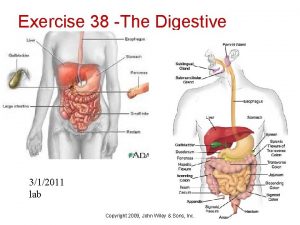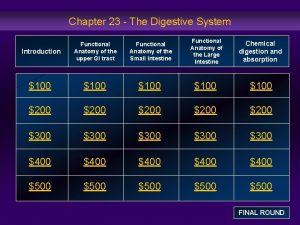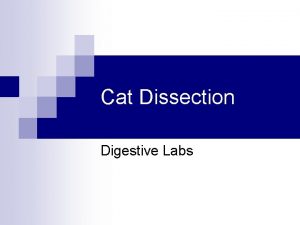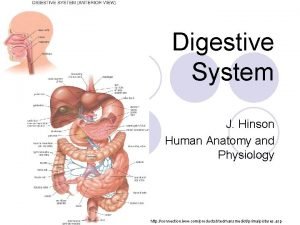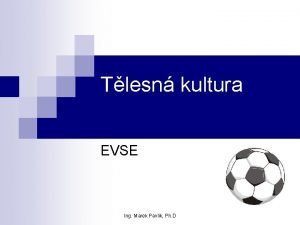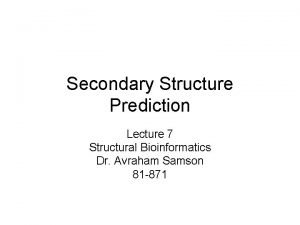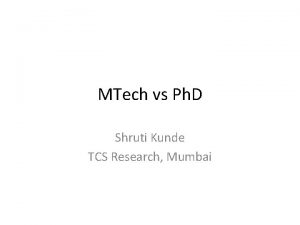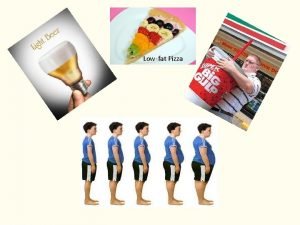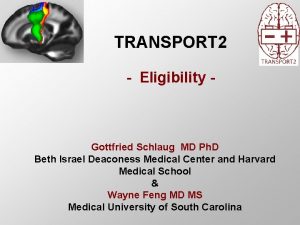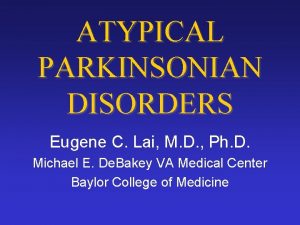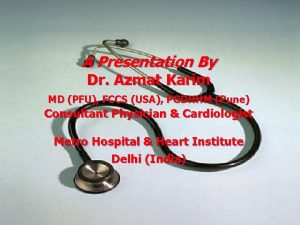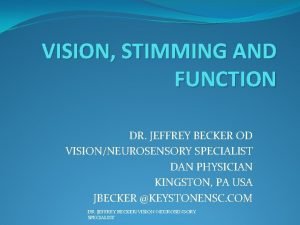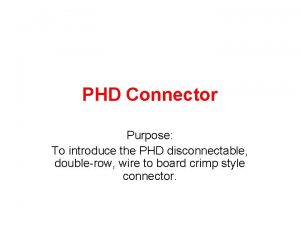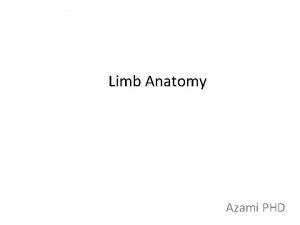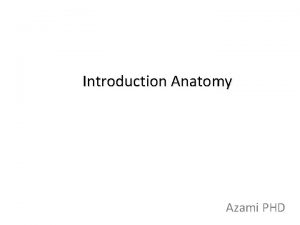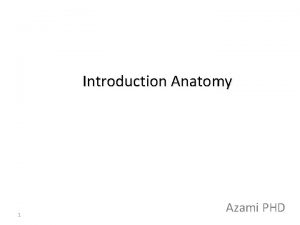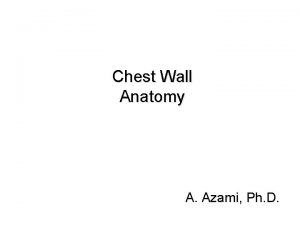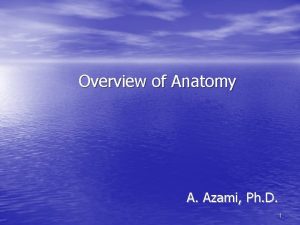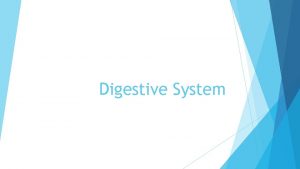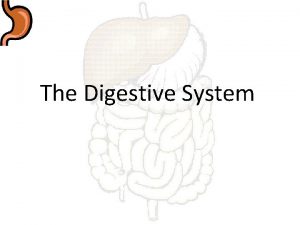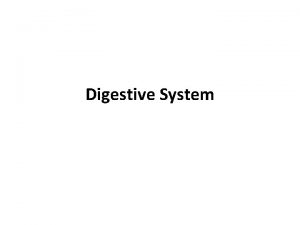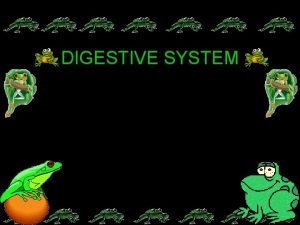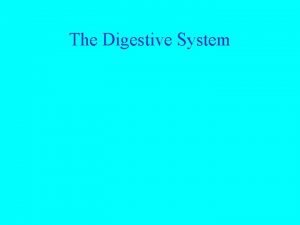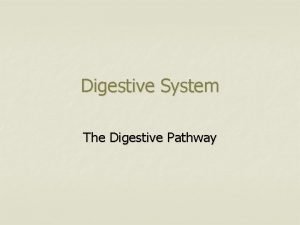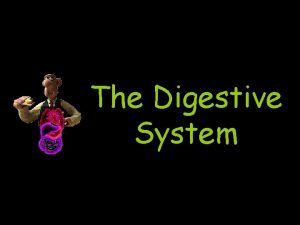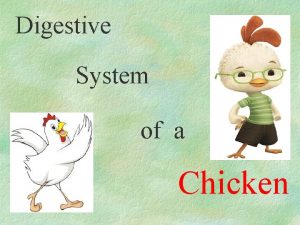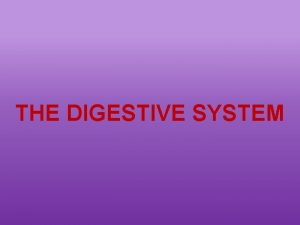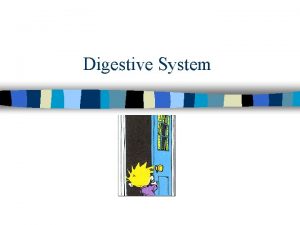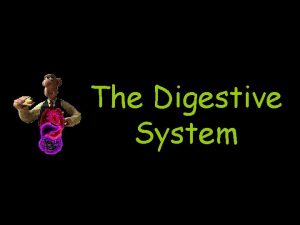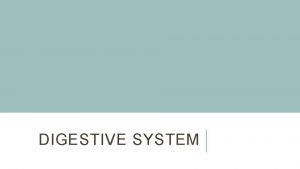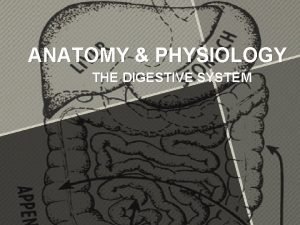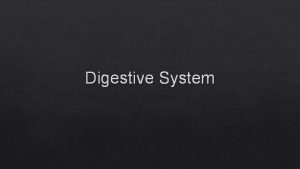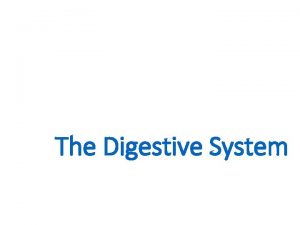Digestive System Azami PHD Digestive System Anatomy Digestive


































- Slides: 34

Digestive System Azami PHD

Digestive System Anatomy • Digestive tract – Alimentary tract or canal – GI tract • Accessory organs – Primarily glands • Regions – – – – Mouth or oral cavity Pharynx Esophagus Stomach Small intestine Large intestine Anus

Oral Cavity • Mouth or oral cavity – Vestibule: Space between lips or cheeks and alveolar processes – Oral cavity proper • Lips (labia) and cheeks • Palate: Oral cavity roof – Hard and soft • Palatine tonsils • Tongue: Involved in speech, taste, mastication, swallowing


Salivary Glands • Produce saliva – Prevents bacterial infection – Lubrication – Contains salivary amylase • Breaks down Starch • Three pairs – Parotid: Largest – Submandibular – Sublingual: Smallest


Teeth • Two sets – Primary, deciduous, milk: Childhood – Permanent or secondary: Adult (32) • Types – Incisors, canine, premolar and molars

Tooth structure:

Pharynx and Esophagus • Pharynx – Nasopharynx – Oropharynx: Transmits food – Laryngopharynx: Transmits food • Esophagus – Transports food from pharynx to stomach – Passes through esophageal hiatus (opening) of diaphragm and ends at stomach

(Swallowing) • Three phases – Voluntary – Pharyngeal • Reflex – Esophageal • Reflex

Digestive Tract Histology

Digestive System Regulation • Nervous regulation – Involves enteric nervous system • Types of neurons: sensory, motor, interneurons – Coordinates peristalsis and regulates local reflexes • Chemical regulation – Production of hormones – Production of paracrine chemicals

Digestive Tract Anatomy

serous membranes

Peritoneum • Peritoneum – Visceral: Covers organs – Parietal: Covers interior Retroperitoneal surface of body wall – Retroperitoneal: Behind peritoneum as kidneys, pancreas, duodenum

• Mesenteries – Routes which vessels and nerves pass from body wall to organs

Mesenteries • Mesenteries – Routes which vessels and nerves pass from body wall to organs

Mesenteries

Mesenteries

Lesser omentum from ventral mesentery

Lesser omentum from ventral mesentery


greater omentum from dorsal mesentery

greater omentum from dorsal mesentery

greater omentum

Greater sac Lesser sac

Stomach Anatomy • Openings – Gastroesophageal : To esophagus – Pyloric: To duodenum • Regions – – Cardiac Fundus Body Pyloric

Stomach Histology: • Layers – Serosa or visceral peritoneum: Outermost – Muscularis: Three layers • Outer longitudinal • Middle circular • Inner oblique – Submucosa – Mucosa

Stomach Histology • Rugae: Folds in stomach when empty • Gastric pits: Openings for gastric glands – Contain cells


Small Intestine anatomy and Histology • Site of greatest amount of digestion and absorption • Divisions – Duodenum – Jejunum – Ileum: Peyer’s patches or lymph nodules • Modifications – Circular folds or plicae circulares, villi, microvilli • Cells of mucosa – Absorptive, goblet, granular, endocrine

Small Intestine Secretions • Mucus – Protects against digestive enzymes and stomach acids • Digestive enzymes – Disaccharidases: Break down disaccharides to monosaccharides – Peptidases: Hydrolyze peptide bonds – Nucleases: Break down nucleic acids • Duodenal glands – Stimulated by vagus nerve, secretin increases water and bicarbonate secretion from duodenal (Brunner's) glands

Duodenum

 öyp mecburi hizmet
öyp mecburi hizmet Exercise 38 anatomy of the digestive system
Exercise 38 anatomy of the digestive system Exercise 38 anatomy of the digestive system
Exercise 38 anatomy of the digestive system Functional anatomy of the digestive system
Functional anatomy of the digestive system Cat
Cat Mucus c
Mucus c Phd comics writing
Phd comics writing Ing marek pavlik phd
Ing marek pavlik phd Phd secondary structure prediction
Phd secondary structure prediction Shruti m tcs
Shruti m tcs Dr adele hite
Dr adele hite Niels fuglsang phd
Niels fuglsang phd Towson university graduate admissions
Towson university graduate admissions Kevin j fleming
Kevin j fleming Revv mac phd spanish
Revv mac phd spanish Amy bunger phd
Amy bunger phd Dr gottfried schlaug
Dr gottfried schlaug Jpsm courses
Jpsm courses Kathleen brehony phd
Kathleen brehony phd William d walsh
William d walsh Lawrence e page
Lawrence e page Eugene lai md
Eugene lai md Dr azmat karim
Dr azmat karim Alison leary phd
Alison leary phd Jeffrey becker phd
Jeffrey becker phd Lisa brenner phd
Lisa brenner phd Phd survival kit
Phd survival kit Doc. phdr. stanislav matulay phd
Doc. phdr. stanislav matulay phd Craig watson md phd
Craig watson md phd School of graduate studies
School of graduate studies Phd connector
Phd connector Bs ms phd joke
Bs ms phd joke Rebecca sutton phd
Rebecca sutton phd John oakes phd
John oakes phd Auto guiding
Auto guiding

